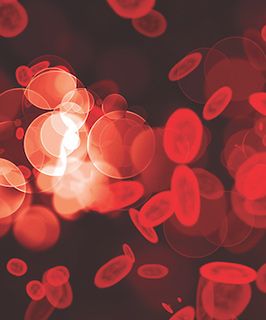Article
Luspatercept-ammt Demonstrates Long-Term Efficacy in LR-MDS
Author(s):
Luspatercept, a first-in-class erythroidmaturation agent, induced high clinical activity in patients with transfusion-dependent, lower-risk myelodysplastic syndromes and ring sideroblasts who were relapsed/refractory to erythropoietin, according to findings from the phase 2 PACE-MDS study.

Luspatercept-aamt (Reblozyl), a first-in-class erythroidmaturation agent, induced high clinical activity in patients with transfusion-dependent, lower-risk myelodysplastic syndromes (LR-MDS) and ring sideroblasts (RS) who were relapsed/refractory to erythropoietin, according to findings from the phase 2 PACE-MDS study (NCT01749514/NCT02268383).1
Investigators said that these data highlight luspatercept’s efficacy across LR-MDS subtypes, including untreated MDS-RS. They noted that the study was underpowered to confirm these data because the sample size was small but said the data show several “novel trends” that deserve further exploration.
At a median duration of 315 days (range, 21-1934) of luspatercept exposure, investigators observed hematologic improvement (HI) erythroid (HI-E) response in 53.7% of patients according to International Working Group 2006 standards, including 36.4% of non-RS and 70.6% of non–transfusion-dependent patients. Furthermore, investigators recorded HI neutrophil in 33.3% and HI platelet in 9.5% of patients. There was a nearly 3-fold increase in bone marrow late to early progenitor cell ratio accompanied HI-E response irrespective of RS status.
Investigators noted that lower baseline erythropoietin levels in non-RS patients (69.6 vs 623.3 IU/L; P = .0077) and higher late to early erythroid progenitor cell ratio (10.44 vs 4.48; P = .0106) in RS patients were associated with HI-E.
The FDA approved luspatercept for patients with LR-MDS with RS in April 2020.2 In findings from the phase 3 MEDALIST trial (NCT02631070), 37.9% (95% CI, 30.2%-46.1%) of patients randomly assigned luspatercept were red blood cell transfusion–independent (RBC-TI) for at least 8 weeks compared with 13.2% (95% CI, 6.5%-22.9%) who received placebo (treatment difference = 24.6%; 95% CI, 14.5%-34.6%; P <.0001).3
However, as the authors of the PACE-MDS trial noted, up to 80% of patients with MDS are non-RS. There is a significant unmet need for treatment options in this patient population, especially following treatment failure with an erythropoiesis-stimulating agent.
Investigators in PACE-MDS enrolled 108 patients with LR-MDS including 44 non-RS and 34 non–transfusion-dependent or previously untreated patients. These data represent results from the largest non-RS group studied to date.
The primary end point was safety. Secondary end points included rates of HI-E, HI neutrophil, and HI platelet. Exploratory end points included erythropoiesis biomarker quantitation and mutation data.
Twenty-two of 42 (52.4%) patients with RS achieved RBC-TI within 8 weeks. The same was true for 34.5% of non-RS patients (P = .139) and 43.8% of transfusion-dependent patients.
Investigators also observed RBC-TI within 8 weeks for 71.4% of low transfusion burden (TB) patients and 26.7% of high TB patients (P <.001), as well as 46.9% of wild-type SF3B1 patients and 51.6% patients with SF3B1 mutations (P = .710). Ten of 13 (76.9%) patients with non-SF3B1 splicing factor mutations (P = .026) and 5 of 19 (23.6%) with no splicing factor mutations (P = .018) also achieved RBC-TI within 8 weeks.
No new safety signals emerged. Rates of related treatment-emergent adverse effects (TEAEs)
for RS patients were 48.4% and 36.4% for non-RS patients (P = .11). In the RS group, the most common TEAEs were fatigue (9.7%) and hypertension and diarrhea (6.5% each). One RS patient progressed to acute myeloid leukemia. Among non-RS patients, headache (11.4%) and hypertension and bone pain (6.8% each) were the most common TEAEs.
References
- Platzbecker U, Götze KS, Kiewe P, et al. Long-term efficacy and safety of luspatercept for anemia treatment in patients with lower-risk myelodysplastic syndromes: the phase II PACE-MDS study. J Clin Oncol. Published online August 23, 2022. doi:10.1200/JCO.21.02476
- FDA approves luspatercept-aamt for anemia in adults with MDS. FDA. News release. April 6, 2020. Accessed August 24, 2022. https://bit.ly/3q0afHf
- Fenaux P, Platzbecker U, Mufti GJ, et al. Luspatercept in patients with lower-risk myelodysplastic syndromes. N Eng J Med. 2020;382(2):140-151. doi:10.1056/NEJMoa1908892









